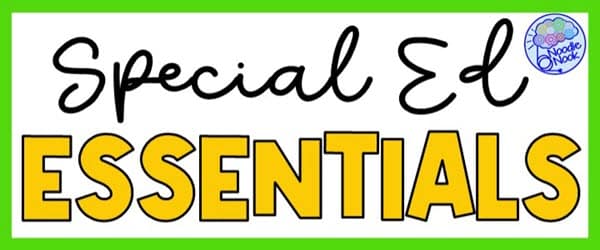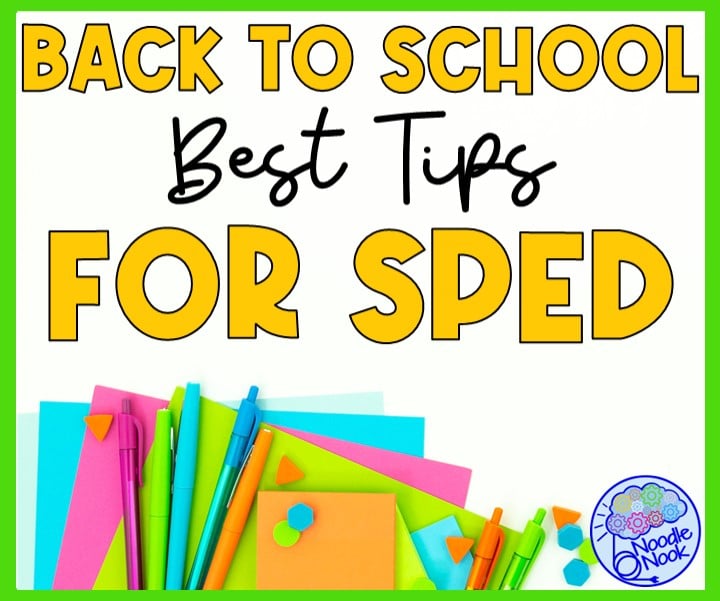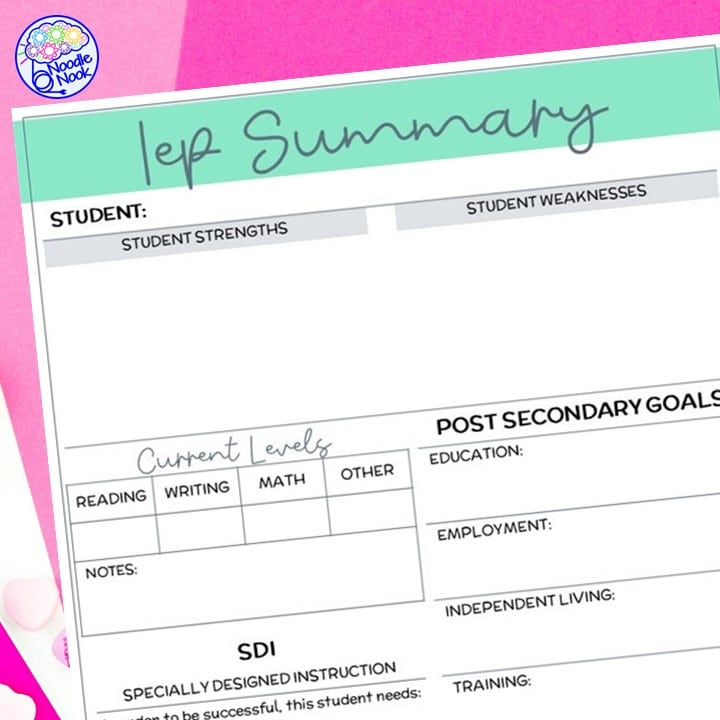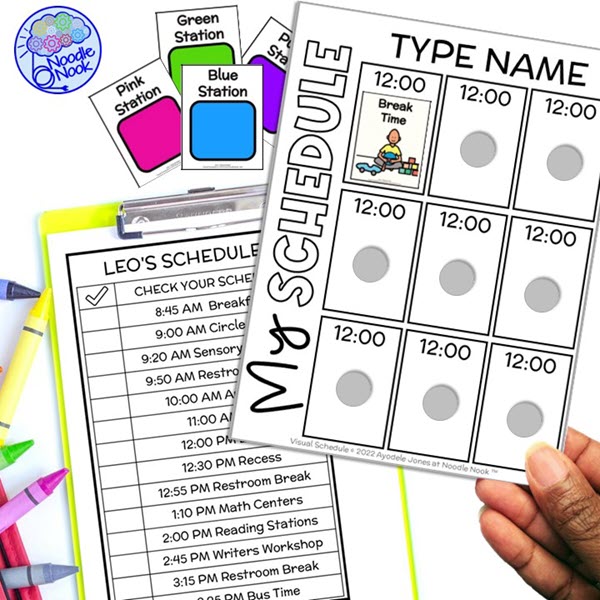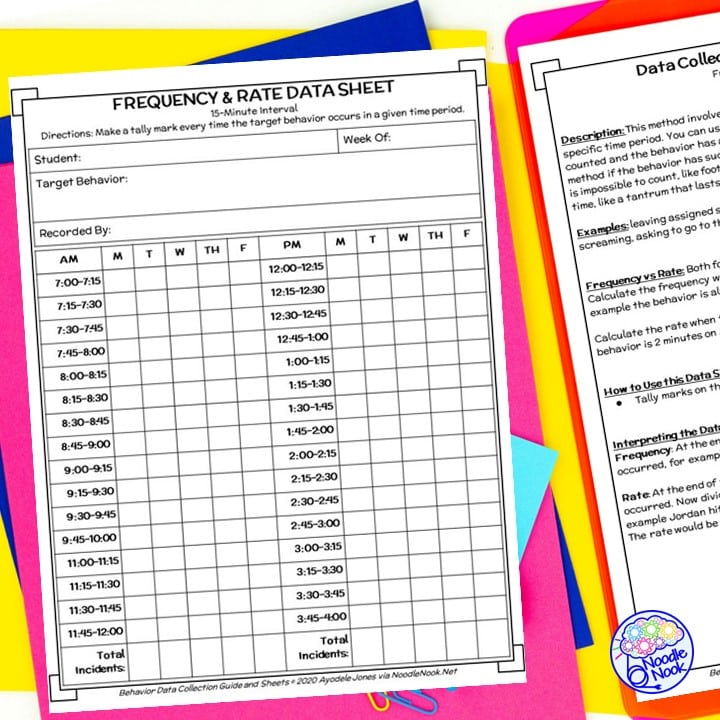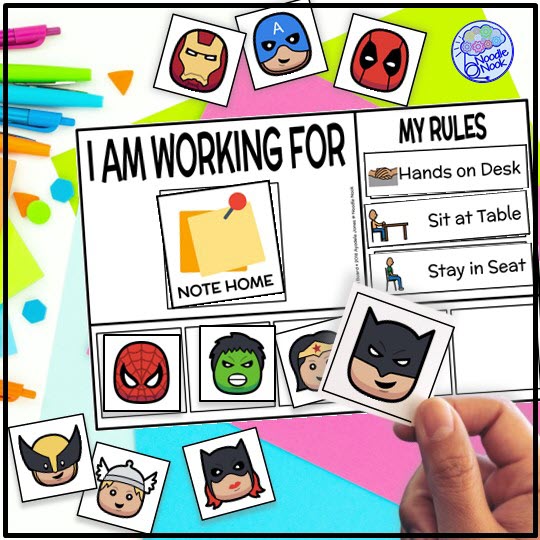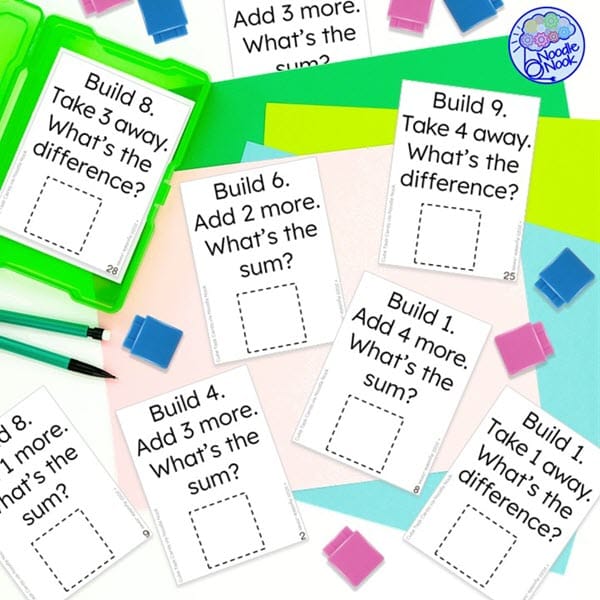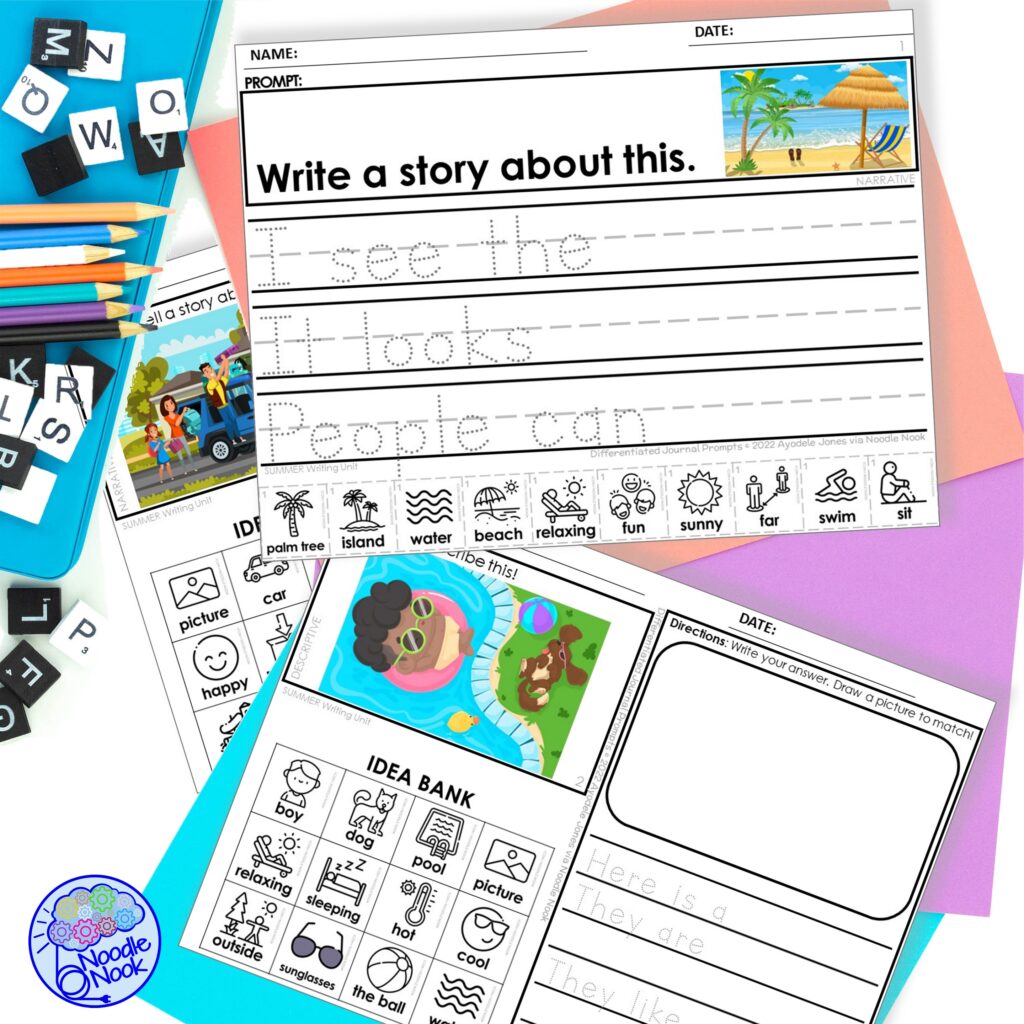Hey there, SpedTacular SpEducator! It’s that time of the year again—the back-to-school season is just around the corner. As you gear up for another exciting year of shaping young minds, we’ve got your back with the 10 best back to school tips for special education teachers just like you. So, grab your highlighters (and the beverage of your choice) and prepare to kick off the upcoming school year on the right foot. We’ve got your to-do start-of-school checklist ready to go!
Rather Listen Than Read?
We got you covered. This post is an episode over on The Noodle Nook Podcast. You can tune in using your favorite provider OR click below to listen now.
Why Prep is Critical!
Life as a special educator is tough. When you read about school tips for the first day of school, they are always targeting general education teachers. We are a whole different breed.
Before the buses roll in on the first day of school, we need to have some solid plans on how to deliver a solid special education program to all our case students. And we are all teaching in different educational settings. Some of us are in a designated special education classroom, and others of us are co-teaching or doing in-class interventions. This means, just like we do for our students, we have to individualize this list.
No matter your setting, preparing for that first day of school is critical. Why?
First, some of our students set their routine for the whole year (or even the entire time they are on our campus) based on that first day of school. That means what we do on day one will inform them of what happens at school on a daily basis. And that can be good… or bad. If you want to get started on the right foot, be prepared. Set in place a solid school-time routine right from the beginning of the school year.
Second, prep is critical because, somehow, a special education teacher’s day is shorter and filled with more paperwork. Okay. Maybe this isn’t exactly true, but it sure does feel true! There is a lot for us to get done and no extra time or extra help to do it. We have to be proactive and get as much time out of our contract time as possible. And that is without taking home a cart full of things we’ll have on our laps when we fall asleep on the couch.
Third, the first days of school are a stressful time for teachers. For new teachers in their first year in the classroom, you’re just trying to survive. For veteran teachers with a few years under their belts, you’re still trying to manage new students, deal with staff turnover from last year, and hit on all those the school districts expectations starting from the first week of school. Yeah… stressed!
Now that we know how critical this all is, try to set aside prep time to complete at least half the things. Personally, I think it’s a good idea to get them all done. But if it seems like too much work, especially at the start of a new school year, target the most critical 5-6 for you.
1. Review Student IEPs
Review and familiarize yourself with each student’s Individual Education Plan (IEP) to understand their specific needs and accommodations. The one thing that is most important as a special ed teacher is following a student’s individualized plan. And… that means you have to know what’s in that plan so you can stay on the right side of due process.
Most of our students don’t get a new IEP over the summer. That means if you’re a returning teacher, then you may not have to deal with a whole new caseload of students and all new IEP paperwork. BUT… even if you’re new, one of the best practices you can get into is regularly reviewing the IEP. We just see things differently when we read things over. You may have not internalized some relevant information from a student’s plan on the first read.
Actually, I think in the world of special education where we’re balancing students IEPs, tracking goals, and managing students and staff in the classroom, that an IEP-at-a-glance is GOLD! As you review your student’s paperwork, fill in an at-a-glance form to make sure you all the information you need. Try this one HERE.
2. Create a Daily Schedule
Create a structured daily schedule that incorporates time for individualized instruction, small group activities, and independent work. I love station instruction and I think that, as school starts, implementing stations from the start is the way to go. It goes a long way to establishing a rhythm and routine in the classroom and set students up for consistency.
As part of that, be sure to post your schedule in a prominent place within the classroom, right from the beginning of the year. Special needs students really benefit from knowing how they will spend their school time and having that set schedule will help minimize anxiety and stress related to transitions. And this helps to keep negative behaviors at bay. And we all want that… right?
So, have a set daily schedule for the school day. And also be sure to share it with your school staff, paraeducators, and related service providers (RSPs). They benefit from knowing what’s happening during the school day too. Especially if you are working with team members who are first time school staff or new to special ed. They have the first day school jitters too. Help everyone have a great year with a solid daily schedule!
Oh! And if you have the schedule set ahead of time, consider sharing it with families at Meet the Teacher school night!
3. Designate Classroom Areas
Set up a designated area in the classroom for independent work, interventions, and small group… and equip them with necessary materials and visual supports.
We do a lot of things in a special ed classroom. Depending on the needs of your students, you can be doing accelerated academics, strengthening social skills, or finding the fun in functional tasks. It will all depend on the student’s IEP. That means we need to set up the school environment for student success. After looking through your paperwork, decide on what areas you’ll need in your classroom. Then designate them and label them if you can. That visual will help students and staff manage within the space.
4. Set Up Data Sheets
Develop a system for data collection to monitor student progress and make informed instructional decisions. Data is a four letter word. And for most of us, special ed or SEN teacher time revolves around data! Getting the data, reporting on the data, and reviewing the data… all in a day’s work!
Since you are going to have to report on data soon (sooner than you think), some of the best advice you can get is to set up your data before school starts. Some students may have new goals to track, but most will have sheets left over from last year. Grab those bad boys and prep away! Get enough to get you through the first two quarters or reporting periods if you can. It will save you some hassle when the first report cards creep up on you. Believe me, parent-teacher conferences are going to be here soon. Be ready with done data!
5. Decide on Routines & Procedures
Establish clear procedures for transitioning between activities, allowing extra time and visual cues for smoother transitions. The routines and procedures you put in place will depend on the needs of your students. It will also depend on their age. Older students in high school need different things than young children in elementary. As a classroom teacher, you’ll want to adjust your routines to meet a child’s needs and help them have the best chances of success.
As you look to teach school routines, there are several to consider. Read more on this by visiting this blog post HERE.
6. Create Essential Visuals
Create visual schedules and visual cues to help students understand and follow the daily routine. If you are a special ed teacher, then you know that the cornerstone of your child-centered classroom is supportive visuals! And since so many of our students struggle with communication, those essential visuals include communication boards or picture exchange systems.
If you are not sure how to meet those needs, check in with related services to see how you can support all your students and their personal nature of the communication supports they need. An occupational therapist, speech therapist, or assistive tech specialist may have some ideas on the best way to support students with visuals that are meaningful. They may also be just the additional support to call in before school starts to get the tea on what’s up with specific students.
Some essential visuals you’ll want to consider are behavior visuals, token board behavior charts, visual schedules, and communication visuals (like a core board). I like generics of most of these things because you never really know what you absolutely need until it’s too late. That means keeping these things ready and on hand can make or break you.
7. Fill In Your IEP Calendar
Develop a system for tracking and managing IEP meetings, ensuring all necessary paperwork and evaluations are completed in a timely manner. Annual IEP meetings creep up on you like the grim reaper! If you want to stay on top of things and never feel surprised when one is scheduled, then do one thing. Fill in all your annual dates on an IEP calendar. At least when you can see them all coming, you’ll feel prepared. Better yet, put each one into your digital calendar and then set the reminder for one month prior. Prep starts early, right?
8. Prep Some Activities
Prepare necessary materials and resources in advance, ensuring they are organized and easily accessible. Speaking of prep, do you have some oh-poo ready? Even if you have a great schedule in place with lots of materials, you are still going to have at least a time or two during that first month of school where the lesson falls short of the time or the students fall short of the lesson. In other words, you’re going to have to keep them busy for a minute!
I love task boxes for go to activities that engage students in academics, functional skills, or prevocational skills. They are the perfect grab and go activities to have on hand at every level. Absolutely 100% have some in your classroom. These easy to prep ones using material already in your classroom or from the dollar tree are evergreen. In other words, they are go-tos any time of year with nearly any student. #Winning
9. Write a Month of Lesson Plans
Plan and implement engaging and multisensory lessons that cater to different learning styles and abilities. That sounds way worse than it is. Hear me out though. I have noticed in my years coaching teachers that most speducators teach in a cycle based on a timeframe (like weekly), or a unit (like a theme or set of lessons). Inside those cycles, we tend to do the same things over and over. And that means creating a simple lesson plan for a month can help you feel like you have direction in those moments when you’re sure you don’t.
If you can, look over the scope and sequence for your grade and content before school starts and set an outline for your lessons. And if you are an overachiever (or decided to stream The Office from start to finish), then create some more detailed lessons incorporating the routines you set up earlier. Your future self will thank you for it!
10. Prep with the Team
Collaborate with support staff, such as paraprofessionals or teaching assistants, to effectively meet students’ needs and promote a collaborative learning environment.
You are not flying solo here. The final tip on this list of best back to school tips for special education teachers is to collaborate and prep with the team. When you work together, everyone wins. Or everyone learns to get along with people they don’t like… which is also a win. No matter how you look at it, being a better team will help students. So do that, even if you don’t really want to.
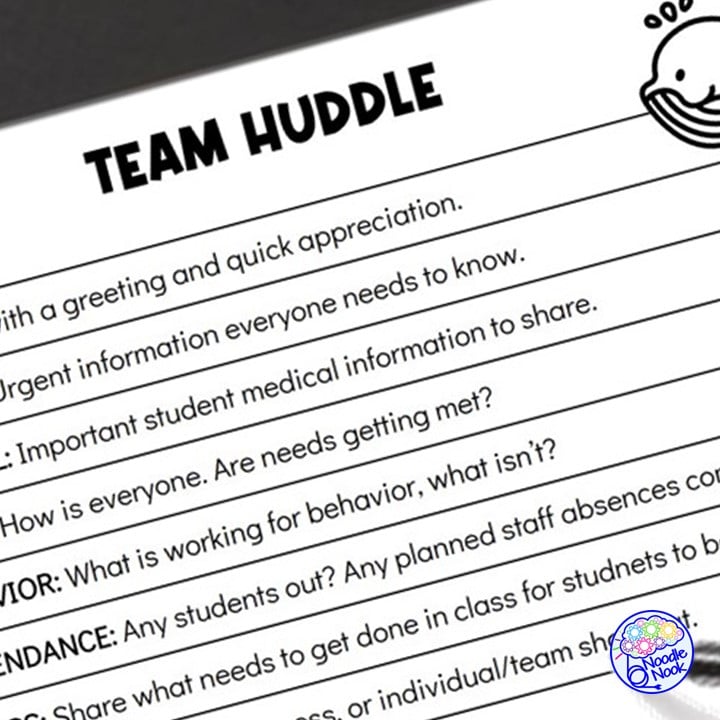
RECAP: 10 Best Back to School Tips for Special Education Teachers
Back-to-school season is upon us, and it’s time to gear up for a successful year ahead. By reviewing student IEPs, creating a structured daily schedule, designating classroom areas, setting up data sheets, establishing routines and procedures, creating essential visuals, filling in your IEP calendar, prepping engaging activities, writing a month of lesson plans, and collaborating with the team, you can navigate the challenges of special education with confidence and create an inclusive and supportive learning environment.
Remember, you’re not flying solo in this journey, and together we can make this upcoming school year the best one yet for our amazing special needs students.
If you loved the images in this post and want to see more special ed resources for your classroom, refill that beverage and check out the Noodle Nook store. Happy back-to-school prepping and cheers to an incredible year ahead!

